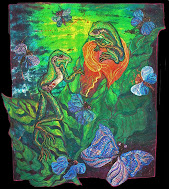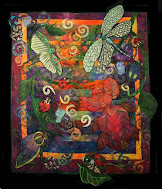Tuesday, May 11, 2010
Fabulous Felt:Unthinking Interfacing
It's funny how inflexible our opinions become. After having worked seven years at Vogue Fabrics in Evanston, IL, I thought I knew everything about every fabric in the main room. I may have come close back then. It was the best fabric education available that I know of.
The main room was the ordinary sewers room. It had domestic cottons, polys, wools and test tube baby fabrics like satins and lace. It also had the craft fabric, with a huge wall of felt.
Felt has gone through a lot of reincarnations. In the 1980's I would have given it the most useless fabric award with bells and ribbons on it.
The original felt of felt skirts and jackets was pure wool. It was a delicious fabric to work with. It was strong, bright and beautiful. By the 80's it also cost the earth. So it was replaced with a hybrid of wool and rayon. This nightmare fabric had curly wool fibers mixed in with straight tree bark fibers (Rayon is made from tree bark.) What a tactical error. Instead of being strong and vibrant, it was always pulling apart( curly and straight fibers don't make a good combination.) At some point I completely wrote it off as a fabric I would ever use again. It didn't even paste together well.
When the first poly felt came out it too was thin and nasty. So I've ignored felt for neigh on 15 years.
So I was completely surprised when Lauren Strach (a fabulous quilter out of St. Joseph, MI) came in with some embroidered flowers where she'd used the new poly felt as a stabilizer.
I began to experiment. I've been making a stabilizer sandwich with hand-dyed fabric, Steam-A-Seam 2,and a final layer of Totally Stable as a pattern. The hand-dye is the surface that the embroidery shows on. The Steam-A-Seam 2 fuses and stabilizes the felt. The felt is fused on to the surface fabric with Steam-A-Seam 2 and then the pattern, made with Totally Stable is ironed onto the felt.
So the sandwich, top to bottom is
Surface fabric
Steam-A-Seam 2
Felt
Totally Stable
I've used it for both bobbin work and for embroidered appliqué. It creates a solid easily applied embroidery where all the distortion is cut off the edge.
You can use wool felt as well. It's pricey and the poly works just as well.
The other thing that makes this work is Sharon Schamber's Halo hoop. This weighted hoop supplies extra support without having to be clamped or unclamped. See my blog Hoop de doo for more information about this fabulous tool.
Wrapping it up:
Poly felt makes a fabulous stabilizer for embroidery. And keep your mind open. Fabrics change all the time. There's no knowing when you'll a new use for something old.
The main room was the ordinary sewers room. It had domestic cottons, polys, wools and test tube baby fabrics like satins and lace. It also had the craft fabric, with a huge wall of felt.
Felt has gone through a lot of reincarnations. In the 1980's I would have given it the most useless fabric award with bells and ribbons on it.
The original felt of felt skirts and jackets was pure wool. It was a delicious fabric to work with. It was strong, bright and beautiful. By the 80's it also cost the earth. So it was replaced with a hybrid of wool and rayon. This nightmare fabric had curly wool fibers mixed in with straight tree bark fibers (Rayon is made from tree bark.) What a tactical error. Instead of being strong and vibrant, it was always pulling apart( curly and straight fibers don't make a good combination.) At some point I completely wrote it off as a fabric I would ever use again. It didn't even paste together well.
When the first poly felt came out it too was thin and nasty. So I've ignored felt for neigh on 15 years.
So I was completely surprised when Lauren Strach (a fabulous quilter out of St. Joseph, MI) came in with some embroidered flowers where she'd used the new poly felt as a stabilizer.
I began to experiment. I've been making a stabilizer sandwich with hand-dyed fabric, Steam-A-Seam 2,and a final layer of Totally Stable as a pattern. The hand-dye is the surface that the embroidery shows on. The Steam-A-Seam 2 fuses and stabilizes the felt. The felt is fused on to the surface fabric with Steam-A-Seam 2 and then the pattern, made with Totally Stable is ironed onto the felt.
So the sandwich, top to bottom is
Surface fabric
Steam-A-Seam 2
Felt
Totally Stable
I've used it for both bobbin work and for embroidered appliqué. It creates a solid easily applied embroidery where all the distortion is cut off the edge.
You can use wool felt as well. It's pricey and the poly works just as well.
The other thing that makes this work is Sharon Schamber's Halo hoop. This weighted hoop supplies extra support without having to be clamped or unclamped. See my blog Hoop de doo for more information about this fabulous tool.
Wrapping it up:
Poly felt makes a fabulous stabilizer for embroidery. And keep your mind open. Fabrics change all the time. There's no knowing when you'll a new use for something old.
Subscribe to:
Post Comments (Atom)
Ellen Anne Eddy's Flowers on Youtube.com
Labels
lunatic fringe
(22)
design
(18)
life as an artist
(18)
lifestyle
(18)
story telling
(11)
art quilting
(8)
fiber art
(8)
art quilters
(7)
books
(6)
color
(6)
free motion
(6)
gardening
(5)
Thread Magic Garden
(4)
embroidery
(4)
quilters
(4)
quilting
(4)
C and T Publishing
(3)
craft
(3)
flowers
(3)
Christmas
(2)
What problem?
(2)
archetypes
(2)
beads
(2)
bias
(2)
bobbin work
(2)
classes
(2)
filling the grid
(2)
sewing
(2)
threads
(2)
zigzag stitch
(2)
Wizard of Oz
(1)
choir
(1)
knitting
(1)
machine stitching
(1)
movies
(1)
seasons
(1)
youtube
(1)
Like us on Facebook

Quiltposium, Fall2011

Ellen's New Article, Dance of Design
Essential Embroidery Stitches: Free Hand and Machine Embroidery Designs and Techniques.
The Butterfly Effect

My Blog List
-
17 hours ago
-
2 days ago
-
1 week ago
-
4 weeks ago
-
3 months ago
-
2 years ago
-
4 years ago
-
5 years ago
-
5 years ago
-
6 years ago
-
6 years ago
-
8 years ago
-
8 years ago
-
8 years ago
-
9 years ago
-
9 years ago
-
9 years ago
-
10 years ago
-
10 years ago
-
10 years ago
-
11 years ago
-
11 years ago
-
11 years ago
-
12 years ago
-
12 years ago
-
12 years ago
-
12 years ago
-
13 years ago
-
13 years ago
-
13 years ago
-
13 years ago
-
13 years ago
-
13 years ago
-
13 years ago
-
13 years ago
-
-
-

Facebook Badge
Labels
archetypes
(2)
art quilters
(7)
art quilting
(8)
beads
(2)
bias
(2)
bobbin work
(2)
books
(6)
C and T Publishing
(3)
choir
(1)
Christmas
(2)
classes
(2)
color
(6)
craft
(3)
design
(18)
embroidery
(4)
fiber art
(8)
filling the grid
(2)
flowers
(3)
free motion
(6)
gardening
(5)
knitting
(1)
life as an artist
(18)
lifestyle
(18)
lunatic fringe
(22)
machine stitching
(1)
movies
(1)
quilters
(4)
quilting
(4)
seasons
(1)
sewing
(2)
story telling
(11)
Thread Magic Garden
(4)
threads
(2)
What problem?
(2)
Wizard of Oz
(1)
youtube
(1)
zigzag stitch
(2)












4 comments:
I'm not sure where the felt goes in the quilt sandwich. Is it used as batting or as stabilizer on the bottom?
Love that fish!
It's a stabilizer. I'll put it onto a quilt which will have batt in it.
Ellen
I have been using acrylic felt as a stabiliser for embroidery for quite a while but with the addition of pellon for extra rigidity in small pieces.
I also use acrylic felt in all my small wallhangings as I find that it does not distort with a lot of stitching and does not create puffiness in the piece.I like my wall hangings to lie flat.
Hi Ellen- I love stitching with felt in many ways- as a backing, as an applique or as the 'front fabric'- It also looks great as a front fabric with sheers on top that are stitched, distressed or burned away in bits. Finally- acrylic felt burns beautifully, with stitching as a resist. The brand most often found in craft shops here is Kunin and it comes in all sorts of colors, including black with purple iridescent fibres blended in (maybe a candidate for some of your sparkly critters?)
Post a Comment